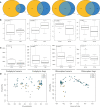Fungal isolates influence the quality of Peucedanum praeruptorum Dunn
- PMID: 36352875
- PMCID: PMC9638934
- DOI: 10.3389/fpls.2022.1011001
Fungal isolates influence the quality of Peucedanum praeruptorum Dunn
Abstract
The symbiotic relationship between beneficial microorganisms and plants plays a vital role in natural and agricultural ecosystems. Although Peucedanum praeruptorum Dunn is widely distributed, its development is greatly limited by early bolting. The reason for early bolting in P. praeruptorum remains poorly characterized. We focus on the plant related microorganisms, including endophytes and rhizosphere microorganisms, by combining the traditional isolation and culture method with metagenomic sequencing technology. We found that the OTUs of endophytes and rhizosphere microorganisms showed a positive correlation in the whole growth stage of P. praeruptorum. Meanwhile, the community diversity of endophytic and rhizosphere fungi showed an opposite change trend, and bacteria showed a similar change trend. Besides, the microbial communities differed during the pre- and post-bolting stages of P. praeruptorum. Beneficial bacterial taxa, such as Pseudomonas and Burkholderia, and fungal taxa, such as Didymella and Fusarium, were abundant in the roots in the pre-bolting stage. Further, a strain belonging to Didymella was obtained by traditional culture and was found to contain praeruptorin A, praeruptorin B, praeruptorin E. In addition, we showed that the fungus could affect its effective components when it was inoculated into P. praeruptorum. This work provided a research reference for the similar biological characteristics of perennial one-time flowering plants, such as Saposhnikovia divaricate, Angelica sinensis and Angelica dahurica.
Keywords: Peucedanum praeruptorum Dunn; endophytes; field experiment; rhizosphere microorganisms; secondary metabolites.
Copyright © 2022 Liu, Wang, Chen, Liu, Song, Yi, Zhu, Wang, Wang, Wang, Song, Jia, Chen, Peng, Guo and Han.
Conflict of interest statement
The authors declare that the research was conducted in the absence of any commercial or financial relationships that could be construed as a potential conflict of interest.
Figures






Similar articles
-
Comparative Transcriptomics Unveil the Crucial Genes Involved in Coumarin Biosynthesis in Peucedanum praeruptorum Dunn.Front Plant Sci. 2022 May 17;13:899819. doi: 10.3389/fpls.2022.899819. eCollection 2022. Front Plant Sci. 2022. PMID: 35656010 Free PMC article.
-
MYB transcription factors in Peucedanum Praeruptorum Dunn: the diverse roles of the R2R3-MYB subfamily in mediating coumarin biosynthesis.BMC Plant Biol. 2024 Nov 28;24(1):1135. doi: 10.1186/s12870-024-05864-1. BMC Plant Biol. 2024. PMID: 39604839 Free PMC article.
-
De novo Transcriptome Sequencing Coupled With Co-expression Analysis Reveal the Transcriptional Regulation of Key Genes Involved in the Formation of Active Ingredients in Peucedanum praeruptorum Dunn Under Bolting Period.Front Genet. 2021 Jun 14;12:683037. doi: 10.3389/fgene.2021.683037. eCollection 2021. Front Genet. 2021. PMID: 34194480 Free PMC article.
-
Research progress of the studies on the roots of Peucedanum praeruptorum dunn (Peucedani radix).Pak J Pharm Sci. 2015 Jan;28(1):71-81. Pak J Pharm Sci. 2015. PMID: 25553708 Review.
-
Traditional uses, phytochemistry and pharmacological properties of the genus Peucedanum: a review.J Ethnopharmacol. 2014 Oct 28;156:235-70. doi: 10.1016/j.jep.2014.08.034. Epub 2014 Sep 3. J Ethnopharmacol. 2014. PMID: 25193684 Review.
Cited by
-
Integrated transcriptomic and metabolomic analysis reveals the regulation mechanism of early bolting and flowering in two cultivars of Angelica sinensis.Heliyon. 2024 Mar 27;10(7):e28636. doi: 10.1016/j.heliyon.2024.e28636. eCollection 2024 Apr 15. Heliyon. 2024. PMID: 38576577 Free PMC article.
-
Comparative metabolic profiling of the mycelium and fermentation broth of Penicillium restrictum from Peucedanum praeruptorum rhizosphere.Environ Microbiol Rep. 2024 Jun;16(3):e13286. doi: 10.1111/1758-2229.13286. Environ Microbiol Rep. 2024. PMID: 38844388 Free PMC article.
-
Analysis of endophytic bacterial diversity of Puerariae thomsonii from different production areas and their correlation with secondary metabolites.Front Microbiol. 2025 May 26;16:1534308. doi: 10.3389/fmicb.2025.1534308. eCollection 2025. Front Microbiol. 2025. PMID: 40491834 Free PMC article.
References
LinkOut - more resources
Full Text Sources

